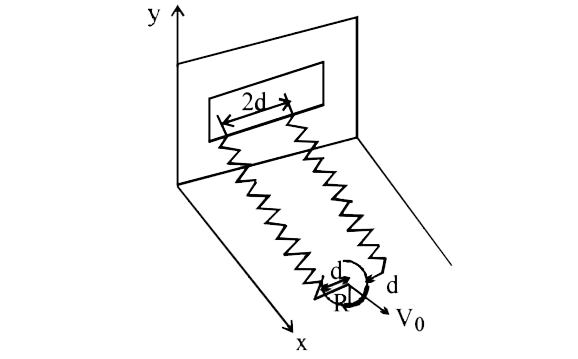When a beam of 10.6eV photons of intensity 2.0W/m2 falls on a platinum surface of area 1.0×10−4m2 and work function 5.6eV,0.53% of the incident photons eject photoelectrons. Find the number of photoelectrons emitted per second and their minimum and maximum energy (in eV).
Take 1eV=1.6×10−19J.Solution in Gujrati
The correct Answer is:6.25×1011, zero , 0.5eV
Energy of incident photon,
E1=10.6eV=10.6×1.6×10−19J=16.96×10−19J
Energy incident per unit area per unit (intensity)=2J
∴ No. of photon incident on unit area in unit time
=216.96×10−19⇒1.18×1014
Therefore, number of photon incident per unit time on given area (1.0×10−4m2)
=(1.18×1018)(1.0×10−4)=1.18×1014
but only 0.83% of incident photons emit photoelectrons
∴ No. of photoelectrons emitted per second (n)
n=(0.53100)(1.18×1014)⇒n=6.25×1011
Kmin=0 and Kmax=E1− work function
=(10.6−5.6)eV=5.0eV
∴Kmax=5.0eV
Topper's Solved these Questions
- SIMPLE HARMONIC MOTIONBOOK - ALLEN CHAPTER - SIMPLE HARMONIC MOTIONEXERCISE - Solved Example
3 Videos
- SIMPLE HARMONIC MOTIONBOOK - ALLEN CHAPTER - SIMPLE HARMONIC MOTIONEXERCISE - X Rays : Solved Example
2 Videos
- SIMPLE HARMONIC MOTIONBOOK - ALLEN CHAPTER - SIMPLE HARMONIC MOTIONEXERCISE - Paragraph
3 Videos
- RACEBOOK - ALLEN CHAPTER - RACEEXERCISE - Basic Maths (Wave Motion & Dopplers Effect) (Stationary waves & doppler effect, beats)
25 Videos
- TEST PAPERBOOK - ALLEN CHAPTER - TEST PAPEREXERCISE - PHYSICS
4 Videos
Similar Questions
A hydrogen like atom with atomic number Z is in an excited state of quantum number 2n. It can emit a maximum energy photon of 204 eV. If it makes a transition ot quantum state n, a photon of energy 40.8 eV is emitted. Find n, Z and the ground state energy (in eV) of this atom. Also calculate the minimum energy (in eV) that can be emitted by this atom during de-excitation. Ground state energy of hydrogen atom is – 13. 6 eV.
View SolutionWhen X-rays if wavelength 0.5Å pass through 10mm thick Al sheet than their intensity is reduced to one sixth . Find the absorption coefficient for Aluminium.
View SolutionA uniform thin cylindrical disk of mass M and radius R is attaached to two identical massless springs of spring constatn k which are fixed to the wall as shown in the figure. The springs are attached to the axle of the disk symmetrically on either side at a distance d from its centre. The axle is massless and both the springs and the axle are in horizontal plane. the unstretched length of each spring is L. The disk is initially at its equilibrium position with its centre of mass (CM) at a distance L from the wall. The disk rolls without slipping with velocity →V0=vacV0ˆi. The coefficinet of friction is μ.

The net external force acting on the disk when its centre of mass is at displacement x with respect to its equilibrium position is.
View SolutionThe frequency of a radar is 780 MHz. After getting reflected from an approaching aeroplane, the apparent frequency is more than the actual frequency by 2.6 kHz. The aeroplane has a speed of
View SolutionChoose the correct statement:
View Solutionwhen a beam of 10.6 eV photons of intensity 2.0 W//m^(2) falls on a platinum surface of area 1.0 xx 10^(4) m^(2) and work function 5.6 eV , 0.53 % of the incidentphotons eject photoelectrons find the number of photoelectrons emited per second and their minimum energies (in eV)Take 1 eV= 1.6 xx 10^(-19) J
View SolutionWhen a beam of 10.6 eV photons of intensity 2.0W/m2 falls
on a platinum surface of area 1.0×10−4m2 and work function 5.6 eV, 0.53% of
the incident photons eject photoelectrons. Find the number of photoelectrons
emitted per second and their minimum and maximum energy (in eV). Take
1eV=1.6×10−19J.
View SolutionA photon energy 3.4eV is incident on a metal having work function 2eV. The maximum K.E. of photoelectrons is equal to
View Solutionजब 10.6eV फोटॉनों का एक पुँज जिसकी तीव्रता 2.0वाट/मीटर 2 है, 1.0×10−4 मीटर2 क्षेत्रफल के प्लेटिनम ( कार्य फलन 5.6 eV )के पृष्ठ पर गिरता है , तो आपतित फोटॉनों में से 0.53% फोटॉन प्रकाश - इलेक्ट्रॉन उत्सर्जित करते हैं । प्रति सेकण्ड उत्सर्जित प्रकाश - इलेक्ट्रॉनों की संख्या तथा उनकी न्यूनतम व अधिकतम ऊर्जाएँ ( eV में ) ज्ञात कीजिए । ( 1eV=1.6×10−19 जूल ) ।
View SolutionPhotons of energy 1.5 eV and 2.5 eV are incident on a metal surface of work function 0.5 eV. What is the ratio of the maximum kinetic energy of the photoelectrons ?
View SolutionA stream of photons of energy 10.6 eV and intensity 2.0Wm−2 is incident on a platinum surface. Area of the surface is 1.0×10−4m2 and its work function is 5.6 eV. 0.53 % of incident photons emit photoelectrons. Find the number of photoelectrons emitted per second and maximum and minimum energies of the emitted photoelectrons in eV. (1eV=1.6×10−19J)
View SolutionA light of intensity 16 mW and energy of each photon 10 eV incident on a metal plate of work function 5 eV and area 10^(-4)m^(2) then find the maximum kinetic energy of emitted electrons and the number of photoelectrons emitted per second if photon efficiency is 10% .
View SolutionMonochromatic photons of energy 3.3 eV are incident on a photo sensitive surface of work function 2.4 eV. , maximum velocity of photoelectron is
View Solution2.0Wm−2 তীব্রতার এবং 10.6eV শক্তির ফটোন স্রোত একটি প্লাটিনাম তলের ওপর এসে পড়ে। ওই তলের ক্ষেত্রফল 1.0×10−4m2 এবং কার্য অপেক্ষক 5.6 eV। আপতিত ফোটনগুলির 0.53% থেকে ফোটইলেকট্রনের নিঃসরণ হয়। প্রতি সেকেন্ডে নিঃসৃত ফটো ইলেকট্রনের সংখ্যা নির্ণয় করো।(1eV=1.6×10−19J)
View Solution6 eV ऊर्जा फोटॉन 4 eV कार्यफलन वाले धातु सतह पर आपतित है। उत्सर्जित फोटो इलेक्ट्रॉनों की अधिकतम गतिज ऊर्जा होगी :-
View SolutionA beam of 10.6 V photons of intensity 2.0W//m^(2) falls on a platinum surface of area 1.0xx10^(-4)m^(2) and work function 5.6eV. If 0.53% of the incident photons eject photo electrons, then find the number of photoelectrons emitted per second and their minimum and maximum energies (in eV).
View Solution
